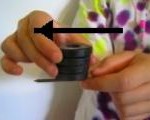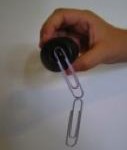 Let’s play around with the idea of lining up all the mini-magnets inside an object to magnetize it. You’ll need a steel nail (steel is a combination of iron and carbon), a magnet (the stronger the better), and a few paper clips. Here’s what you do:
Let’s play around with the idea of lining up all the mini-magnets inside an object to magnetize it. You’ll need a steel nail (steel is a combination of iron and carbon), a magnet (the stronger the better), and a few paper clips. Here’s what you do:
[am4show have=’p8;p9;p21;p48;’ guest_error=’Guest error message’ user_error=’User error message’ ]
1. Take a nail in one hand and the magnet in the other.
2. Stroke the magnet along the nail. Make sure to always stroke in the same direction. From the head to the tip for example. Do that at least twenty times.
3. Now see if your nail can pick up any paper clips. Feel free to strengthen your magnet nail by continuing to stroke the nail with the permanent magnet.
You actually twisted and turned atoms! As you moved the permanent magnet over the nail the iron atoms in the nail actually turned, to align themselves with the magnetic field of the magnet. Once enough iron atoms turned the nail itself became a magnet!
Now let’s destroy the magnetized nail… and turn it back into a regular old nail. Here’s what you do:
1. Drop it on a hard surface. A table, floor or sidewalk would work well.
2. Drop it again.
3. Drop it again.
4. Drop it….you get the picture. Drop it four or five times.
5. Now see if it picks up any paper clips. Is the nail still a magnet?
Here you took atoms that were all nicely lined up and messed them up so they pointed in different directions. Since they weren’t lined up as nicely anymore they had much less or perhaps no magnetic force. If you remember the magnets in a box that we were talking about before. This is like you took that box that had all the magnets lined up and dropped it. CRASH! They get all jumbled up and next thing you know the box no longer has nearly as strong of a magnetic force.
Magnets Are Picky Where They Are Sticky
 “So, how come I can get a magnet to stick to a refrigerator but not my brother’s head?” Ah, I’m glad to see that you’re experimenting! (You might not want to use your siblings as test subjects though…just a thought.) In a way, you could say that magnets only stick to other magnets. I know you refrigerator is not a magnet but bear with me for a second. Your fridge is made of a metal that has iron in it.
“So, how come I can get a magnet to stick to a refrigerator but not my brother’s head?” Ah, I’m glad to see that you’re experimenting! (You might not want to use your siblings as test subjects though…just a thought.) In a way, you could say that magnets only stick to other magnets. I know you refrigerator is not a magnet but bear with me for a second. Your fridge is made of a metal that has iron in it.
Remember that each iron atom is kind of like a little magnet. So your fridge is made of bunches of little magnets. The reason you can’t stick paper clips to your fridge is that all those little “atom magnets” are pointing in different directions and canceling out their magnetic fields. But what happens when a magnetic field gets close to those little “atom magnets”? They turn. The atoms turn so that their poles are opposite of the poles of the magnet. (We’ll talk more about poles in a later lesson.)
Since they have turned, they now act like a magnet and the fridge magnet can now be attracted to the atoms in the fridge. Once you remove the fridge magnet, the atoms in that part of the fridge go back to being mixed up. Here’s what you do:
1. Attach a paper clip to your magnet.
2. Can you dangle another paper clip from the end of your first one?
3. How many can you dangle from each other. Two, three, four, more?
4. What happens if you remove the permanent magnet from the top of the chain?
The paper clips became temporary magnets didn’t they? The permanent magnet turned the iron atoms in the paperclips so that they aligned with the field of the permanent magnet. Since those atoms are all facing in a similar direction, they can now create a magnetic field of their own. So the paper clip becomes a magnet as long as a magnet is near it. Once the permanent magnet gets too far away, the atoms go back to mish-mosh and no longer have much of a magnetic field.
[/am4show]


If you use a magnet that is strong enough, some iron atoms will remain aligned even after you remove the magnet. In your example, enough iron atoms stayed aligned in order to create a magnetic field strong enough to attract a second paperclip.
Our second paperclips are still staying stuck to the top paperclip, even when the magnet is removed and taken far, far away. How come?
Hi my mom Elizabeth fox.
my name Elinor fox
And I like science.
The nail has iron atoms going all which ways, while the magnet has iron atoms that are fairly lined up. The more lined up the iron atoms are, the stronger the magnetic force. If you randomly swipe the nail with a magnet, you’re not going to line up the domains as well as if you went only in one direction over and over. Check out the reading for this unit to get a better picture of what’s going on.
If you rubbed the magnet and nail together randomly, or back and forth, something other than in the same direction, after magnetizing it, would it “de-magnetize” the nail, like it does when you drop the magnet a few times?